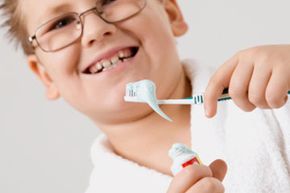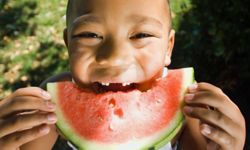Major health organizations such as the Centers for Disease Control and Prevention and the American Academy of Pediatric Dentistry agree that fluoride offers significant benefit to oral health. In low concentrations, fluoride from drinking water, toothpaste and other sources strengthens tooth enamel, prevents cavities and helps build strong, healthy teeth. In higher concentrations, however, fluoride is essentially a highly toxic poison [sources: Danoff, Meyer].
Since 1997, the Food and Drug Administration (FDA) has required manufacturers to print warning labels on tubes of fluoride toothpaste sold in the U.S. [source: Fluoride Action Network]. These labels are designed to make parents aware of the potential for serious health risks in children who consume too much fluoride. Despite these warnings, most children still use too much toothpaste when they brush their teeth, and about half swallow the toothpaste rather than spitting or rinsing [source: Porterfield]. Even worse, curious children or those tempted by the fruity flavors of kids' toothpaste may decide to eat a large amount of the goo straight from the tube, exposing themselves to a possible fluoride overdose.
Advertisement
To protect kids from fluoride-related dangers, parents should treat toothpaste like any other harmful chemical and keep it locked up when not in use. Doctors recommend supervising children younger than age 6 while they brush and reminding them to spit out the paste rather than swallowing. Parents should also use this time to teach kids to use no more than a pea-sized amount of toothpaste. Children age 2 and younger shouldn't use fluoride toothpaste unless directed to by a dentist or doctor, and infants younger than 6 months should never be exposed to fluoride toothpaste [source: Danoff].
When used properly, fluoride toothpaste is unlikely to pose any serious risks to your child. However, swallowing more than a pea-sized amount each day increases a kid's risk for dental fluorosis, a condition that leads to brown spots and staining of the teeth [source: Wagner]. Your child faces an even greater chance of developing fluorosis if they consume fluoride from other sources, such as drinking water, food or mouthwash. While every child's tolerance to fluoride is different, eating small amounts of toothpaste has been linked to gastrointestinal problems ranging from vomiting to diarrhea [source: Ager]. Kids who eat small amounts every day can even develop chronic health issues, including problems with bone development [source: Oldenburg].
But what happens if you suspect your child has eaten a large amount of fluoride toothpaste? Read on to learn about lethal fluoride doses and when you should call poison control.
Advertisement

